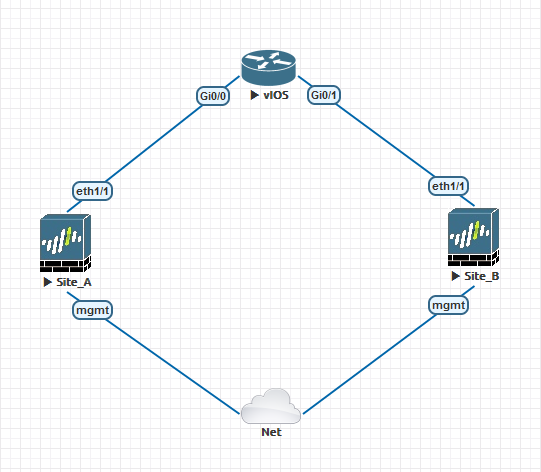Unsurprisingly running FMC on Proxmox is not specifically listed as a recommended deployment platform on the Cisco page, but KVM deployment is. The image from Cisco comes in qcow2 format which needs a bit of tweaking to work on Proxmox... I'll be using Proxmox 8.1 and FMCv 7.2.0-82 . Creating the VM is fairly standard... Continue Reading →
Running EVE-NG on Proxmox host
Proxmox is not officially supported by EVE-NG, but it allows for host virtualisation and allows for over 16 cores per VM without a license, so it is worth a try. This post uses the latest Proxmox 8.0.3 build, installed on a single SSD on my lab (cyberpunk2077/ HLL /Starfield/ whatever is the next AAA games... Continue Reading →
Palo Alto – tunnel VRF with IPSec
This posts covers implementing a 'tunnel VRF' topology detailed in <this post>. Essentially we are providing a method of routing between customer VRs across a WAN via (IPSec) tunnel, without needing to import the WAN routing table prefixes into customer VR. Arguably you could have the customer and WAN prefixes in one routing table and... Continue Reading →
Palo Alto 11.0.1 VM on EVE-NG with initial configuration
Getting the latest v10.0.1 Palo Alto VM up and running on EVE-NG
EVE-NG – SONiC switch template
A tweaked SONiC switch template to use when the management VRF has been enabled. Simply changes to the interface names to match what is used by the SONiC OS. Copy the following into the following locations: /opt/unetlab/html/templates/amd/sonicswvrf.yml/opt/unetlab/html/templates/intel/sonicswvrf.yml # Copyright (c) 2016, Andrea Dainese # Copyright (c) 2018, Alain Degreffe # All rights reserved. # #... Continue Reading →
EVE-NG – SONiC switch configuration via CLI
This post will look at the configuration steps to get a functioning SONiC switch lab using the CLI. The topology will be a non-redundant pair of clusters each containing two leaf switches connected to a spine switch. The spine switches are connected to an agregation switch. The switches are all running at Layer3 with eBGP... Continue Reading →
Cisco Designated VIP 2022
It was a bit of squeeze this year to find time to contribute on the Cisco Community forum with a busy work schedule and then moving to FTE at the end of the year, but I am pleased to say I made it into the Cisco VIP 2022 group!
Expired authentication keys
We all know that authentication should be implemented between peers when using a routing protocol. Better still, instead of using a single static key a key-chain should be used so that they can be automatically rotated and via automation you can keep removing and adding keys to the chain to keep the endless cycle going.... Continue Reading →
IT Blog Awards 2021 – Finalist
This very blog here which you are reading has made it to the IT Blog Awards 2021. Do the right thing and cast your vote : https://www.ciscofeedback.vovici.com/se/705E3ECD767BAEDD
Static route next-hop
Static routes are a much loved and well used configuration staple but this post will highlight a possible misconfiguration step and explore the behaviour. In cisco IOS a static route is defined by: ! ip route <destination_prefix> <destination_mask> <interface> <next-hop> ! While it may be common to omit the the outgoing interface, it is also... Continue Reading →








